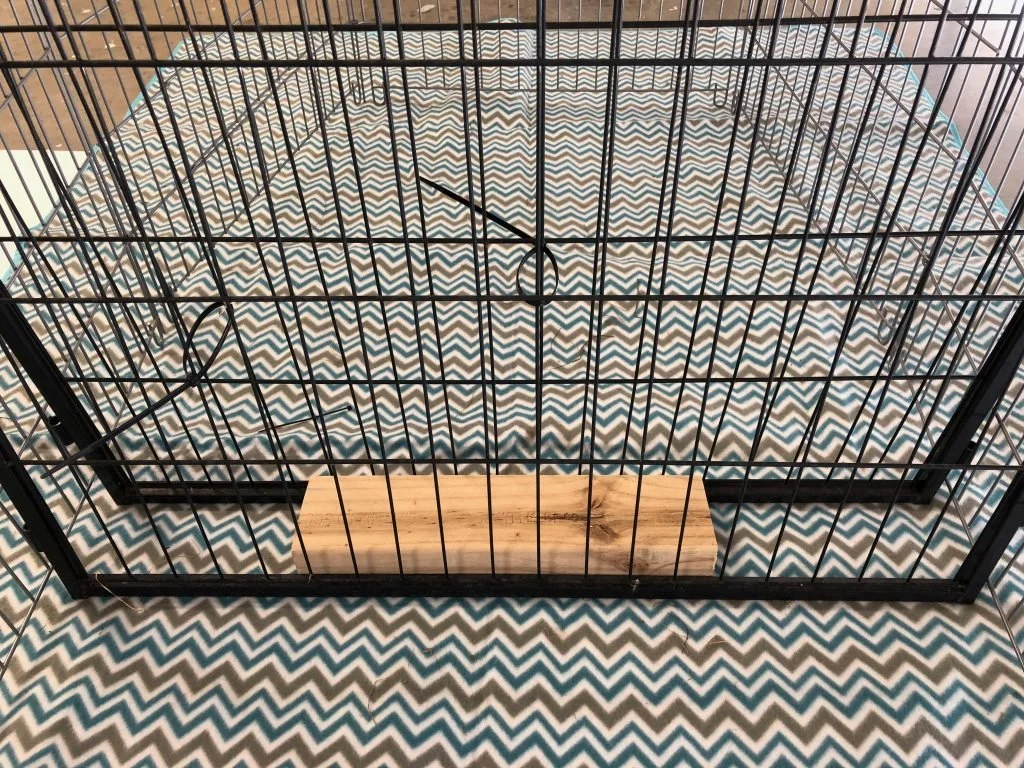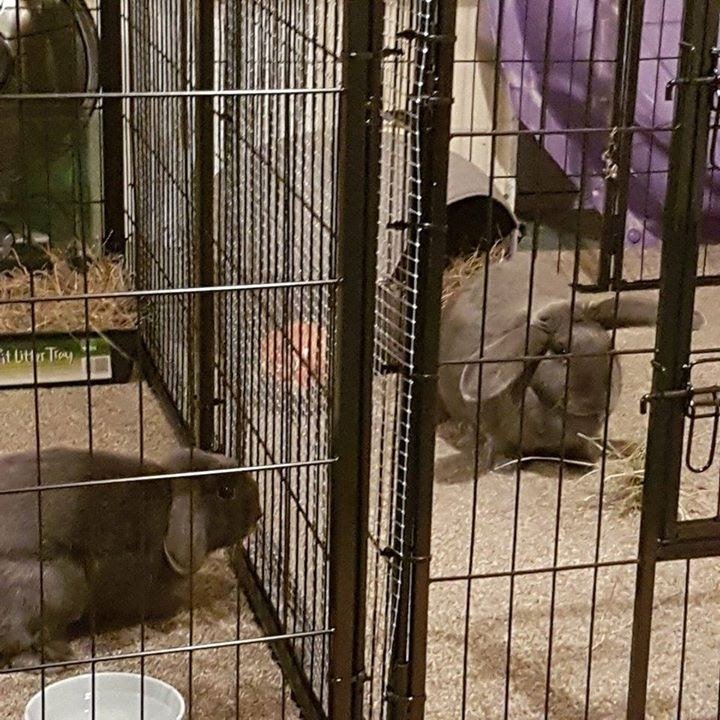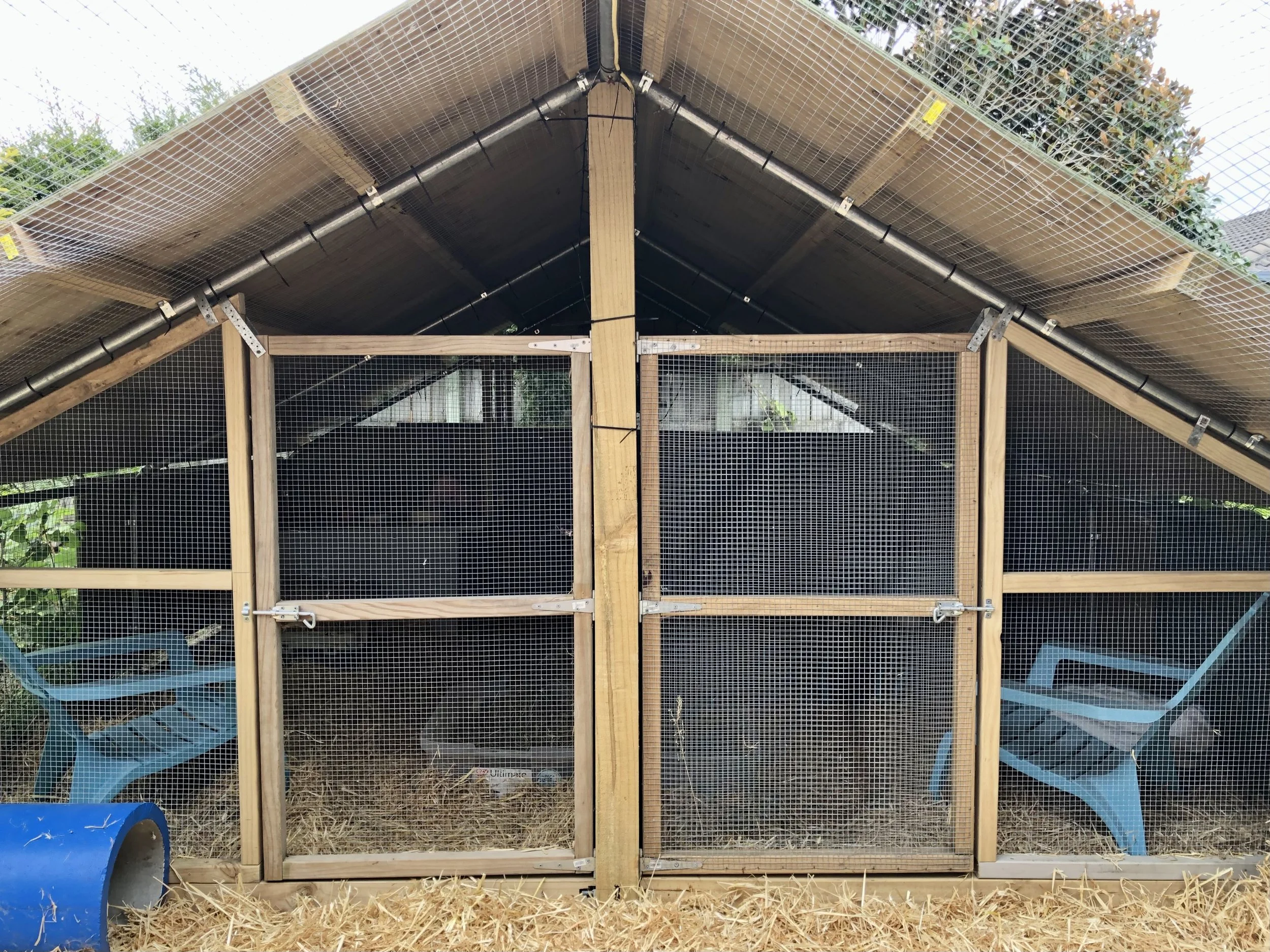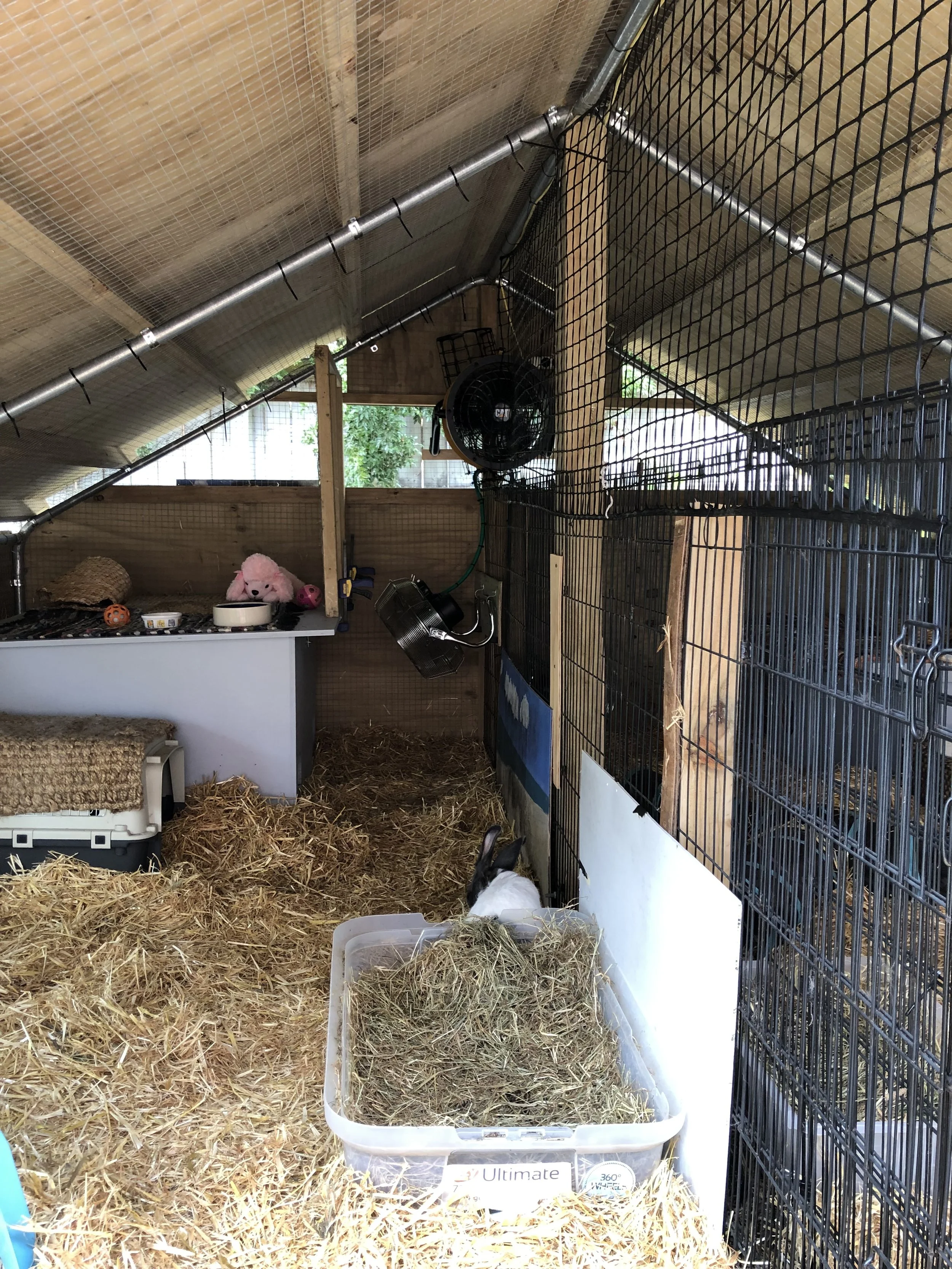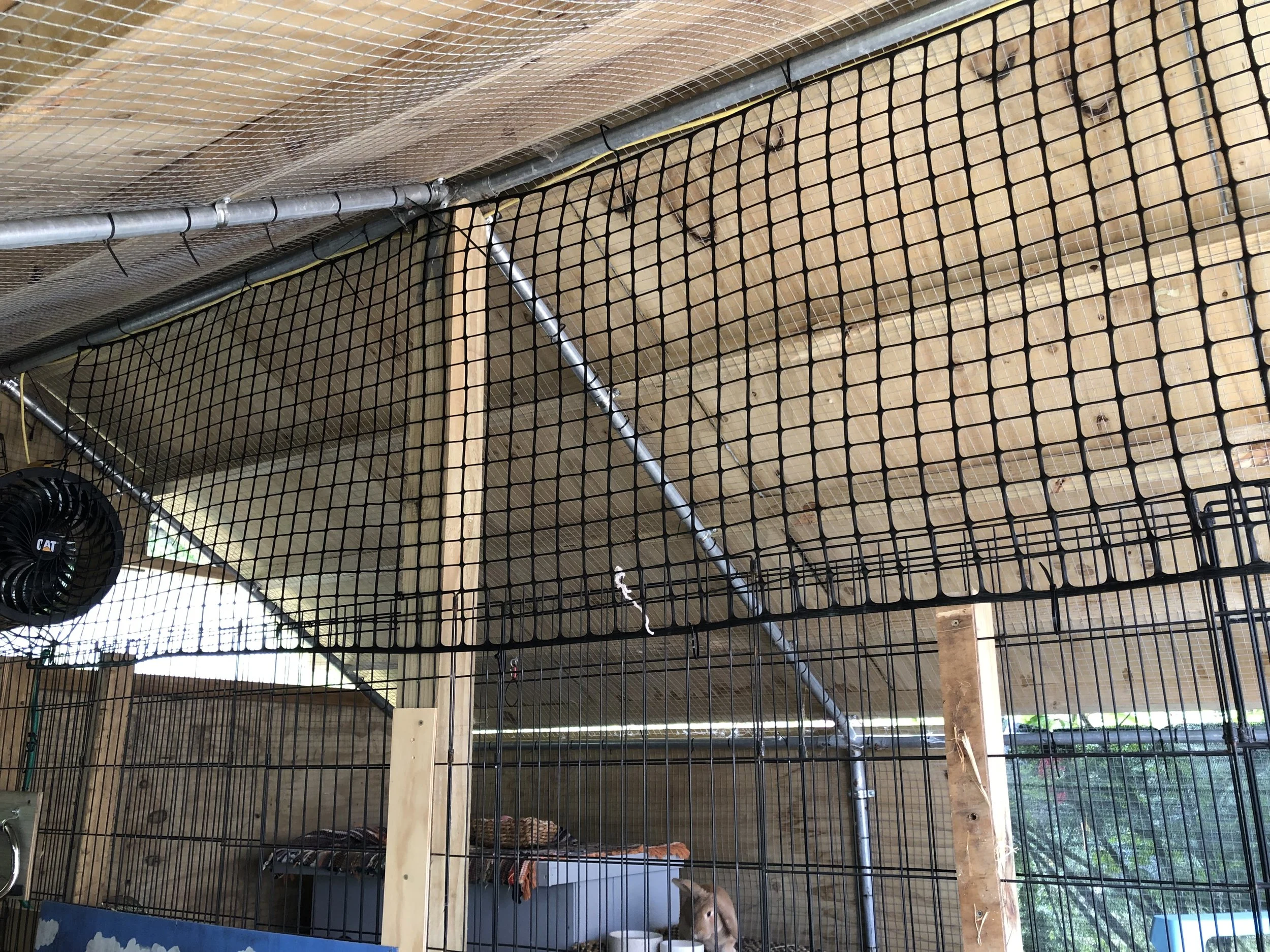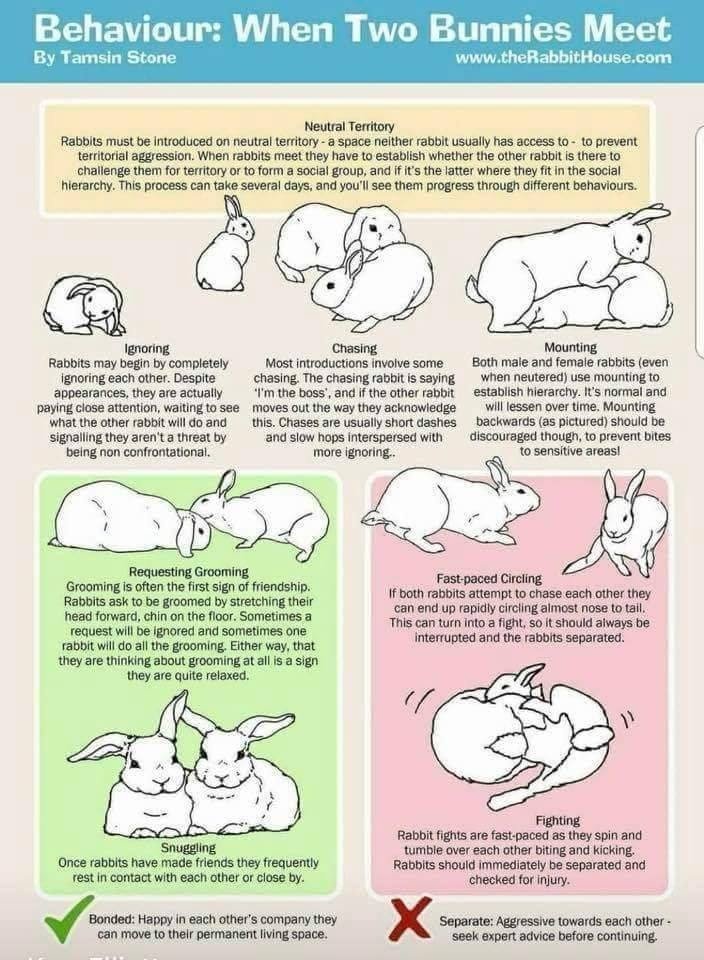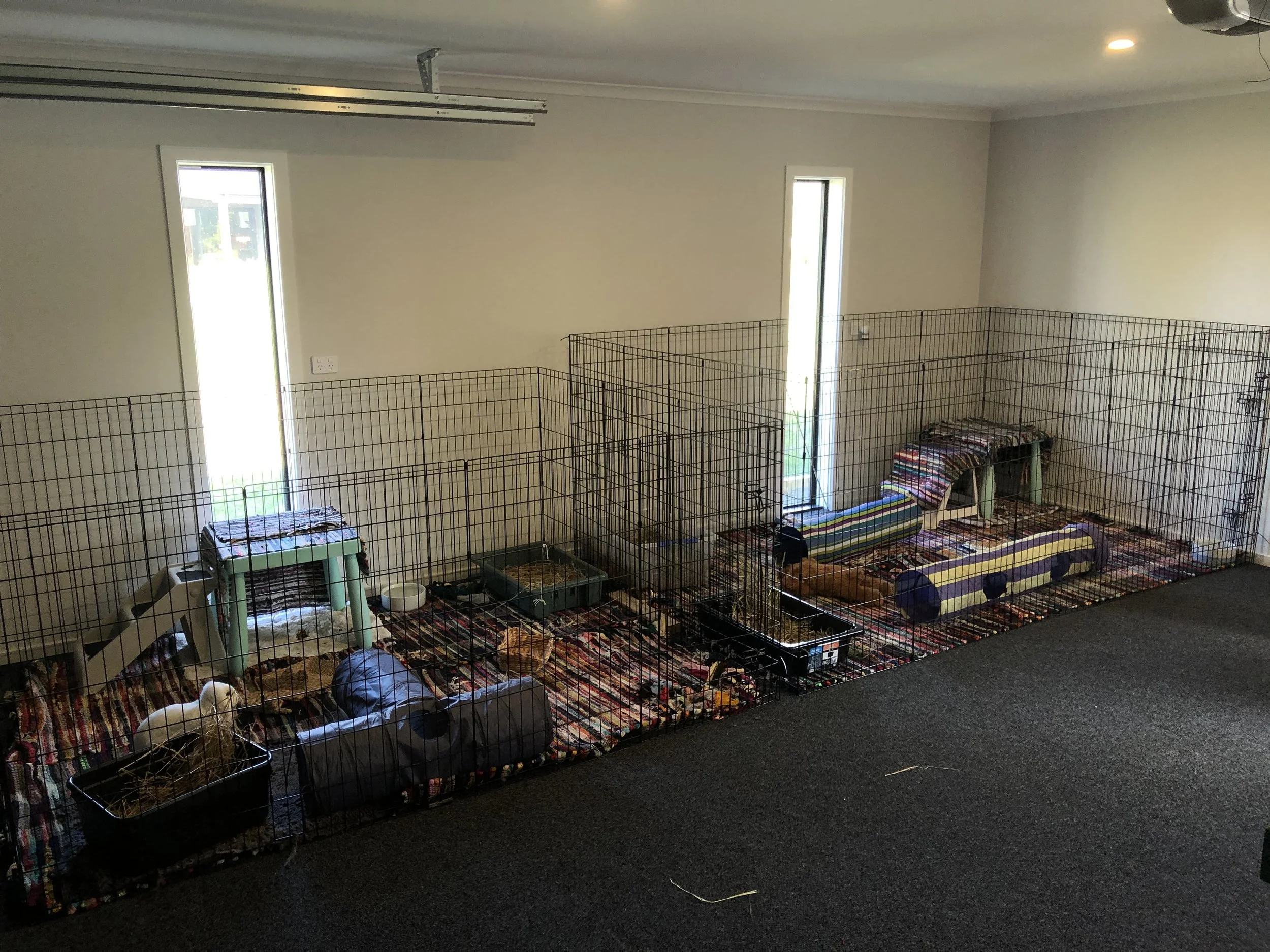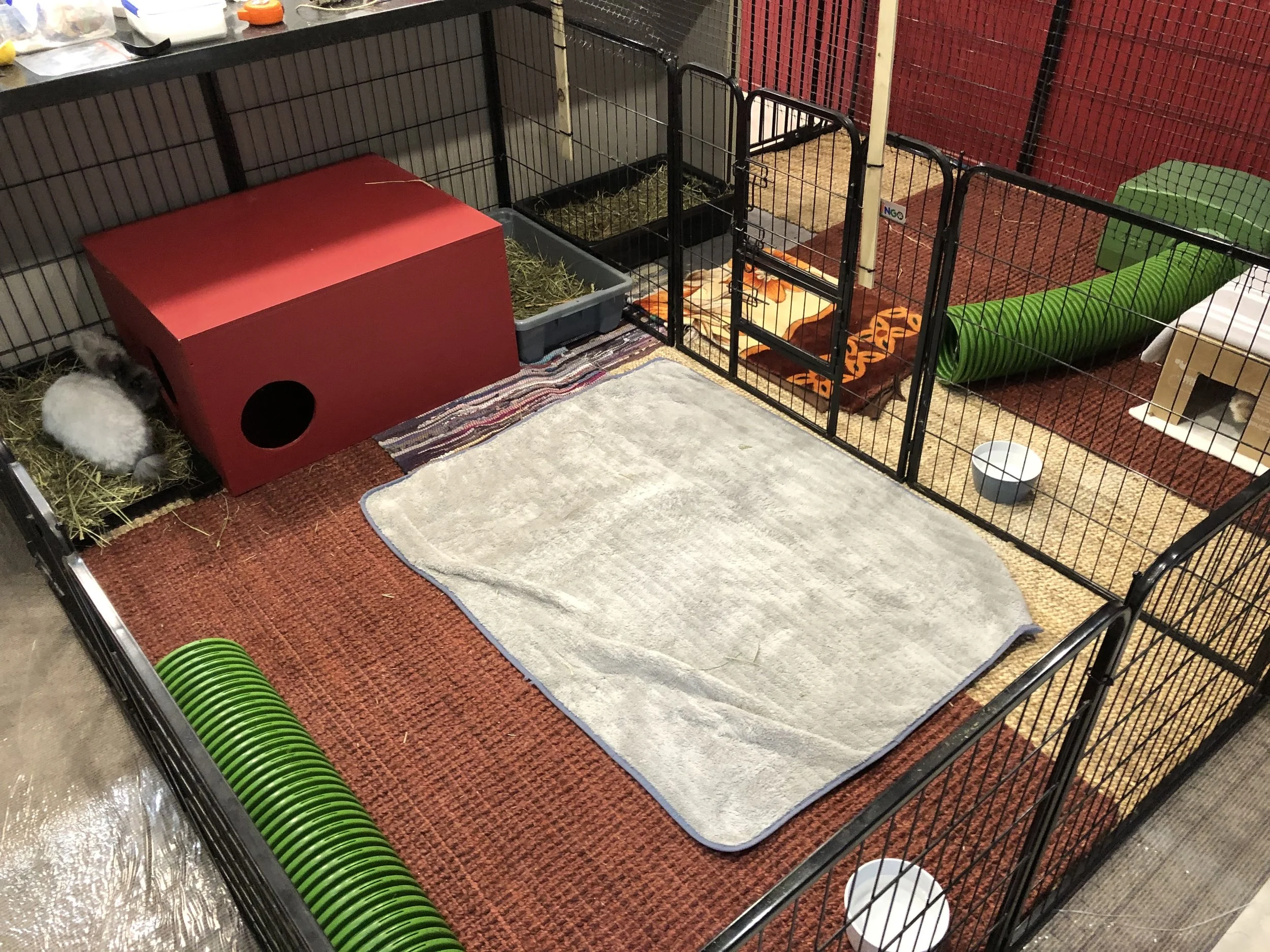Bonding
Westley's World advocates the long and slow approach to bonding between desexed M:F pairs.
Both rabbits must be desexed and a minimum 4-6 weeks post desex before face to face meetings are attempted.
Please read this file carefully in preparation to starting the bonding journey with your rabbits.
For expert advice, Shileigh from Bunny Boarding North Shore offers a specialised Bonding Consultancy Service.
PLEASE NOTE - Some of the links at the bottom of this file, other groups and some rescues promote the following practices which WW does not support ...
Only Desexing One Rabbit -
This is ill advised for multiple reasons among them being -
* The entire rabbit is at risk of reproductive cancers
* Difficulties maintaining toilet training
* Hormonally driven undesirable behaviours like spraying, humping and aggression
* The entire rabbit paying unwanted attention to or becoming frustrated with the desexed rabbit leading to fighting
* The female if entire having repeated phantom pregnancies due to the hormonal male's presence.
Swapping litter trays -
Early in the bonding process swapping of the rabbits’ litter trays etc so the rabbits can get used to each other’s smell and neither of them ‘owns’ a certain pen etc. We have found that this can actually cause territorial behaviour between the rabbits to escalate. They can easily see and smell each other if they are housed side-by-side - they know there is another rabbit RIGHT there! To begin with letting each have their own ‘bedroom’ eases their need to be on guard constantly and can help them to relax in each other’s company. Once they are comfortable with each other and are ready to start having dates, if the rabbit's will eventually live in the area that is currently divided as a common area then swapping territories can help blend them to become ‘theirs’ vs ‘his and hers.’
Stress Bonding -
Another technique discussed is stress bonding. This approach must be used with extreme caution and is best left to experienced rabbit people to undertake and can often result in unstable bonds.
Same Sex Pairings -
Also mentioned are same sex pairings - for example M:M or F:F. WW actively discourage these pairings due to the potential fragility of the bond. Fighting can happen at any time - even years after bonding, and can result in serious injury, expensive vet bills or even the death of one or both of the rabbits. The Perils of Same Sex Pairings has more information.
Speed Dates -
The act of forcing two rabbits together under any circumstance is counterproductive and will only cause them unnecessary distress. Some groups and rescues really push this technique and say that if the rabbits do not get along in the first hour then a bond between those rabbits is not possible, but this is simply not true. They also say that side-by-side bonding is stressful to the rabbits but if it is done carefully - in my experience, once the excitement of the initial few days has passed, the rabbits cope very well. Subjecting rabbits to a series of speed dates; and I’ve heard of one poor rabbit being subjected to close to 20 unsuccessful ‘dates’, is in my opinion far more stressful than a low key, gentle, organic and patient approach to bonding.
Some Bonding Scenarios
‘YAY! My Baby Rabbits are Bonded!‘
Please be aware that a bond between rabbits of any sex is not a true bond until they reach adulthood. Prior to puberty - which can start any time from 3 months or so for males and 4 months for females, they are friends simply because they are young rabbits. After that - if a same sex pair, they will view each other as potential threats, even when desexed. This is why we promote opposite sex, desexed bonds as it is the most stable combo long term.
So, if you have a young Male:Female pair - let’s say siblings, they may be happy together whilst young, but they are actually not truly bonded. It is also important to know that once they reach the 10-12 weeks mark it is essential to seperate them because the male will be entering puberty at this age. Even though the female is young, the male will potentially be able to get her pregnant once he is around 12 weeks old and although it is rare she could potentially become pregnant from around 4 months old.
To separate them, you will ideally have them in a side by side set up with a gap between the pens - because they can mate through the bars/mesh. Then you need to wait until they are old enough to desex. You can either wait until they are both around 5-6 months old and have both desexed at the same time, or have him desexed as soon as his testes descend and then once she reaches 5-6 months (6 is better for her) have her done and once she has recovered and her hormones have settled - a minimum of 4 weeks, you can proceed to bond them, which again should be a fairly straight forward and easy process by this stage.
Same Sex Pairs
When it comes to rabbits you need to be aware that they are controlled by instinct even when the hormones are controlled by desexing. Rabbits are also very territorial. So trying to bond same sexes can be very difficult and even when it appears they are getting along it can change in the blink of an eye. This can happen because of something that we humans may not even be aware of, such as the arrival of a new rabbit down the street - we can’t smell it but they can, a change in their surroundings, new people, new pets, one of the rabbits was away at the vets etc. All sorts of things can upset bonds. To make it worse, rabbits have very good memories and if they have previously had a fight they will most likely fight again. Which is why we strongly advise to desex before it gets to that point.
The Perils of Same Sex Pairings
Bonding Free Roam Indoor Rabbits - This video has some really good advice on how to go about this.
Bonding Free Roam Rabbits
If your existing rabbit is a free range bun either indoors or outdoors, then you will need to prepare for the arrival of a new addition ahead of time. Because the existing rabbit has had unfettered access to the whole territory it is best to divide their area so that some of it will ‘belong’ to the new rabbit.
So ... how do you begin to go about this Bonding business?
Getting set up and ready - It is ESSENTIAL that your side-by-side set up is FULLY secure. This means that the rabbits cannot push to move, go under, over or through the panels by using heavy duty panels with an absolute MINIMUM height of 80cm. 1.2m panels are better and are the recommended height to start with. Hence - The K-Mart and Warehouse 60cm light weight panel are 100% not sufficient because they are too low and too easily moved, pushed and lifted.
You may even need to increase the height further or add tops etc to the pens to ensure that there is absolutely NO way the rabbits can get to each other before they are ready for fully supervised dates in 100% new/novel/neutral territory. You can see ideas for increasing height and making toppers here - Pen Toppers
An important note - With any side-by-side set up you will need to make sure that no biting can happen through the bars in the initial stages. There are a couple of ways to do this -
1. Either have about a 10cm gap between the panels - use something like some 4x2 on its side at both the bottom and the top of the panels to space the them apart so they cannot be pushed together by the rabbits.
or…
2. Attach weld mesh to the dividing panels.
Doing this stops aggression and biting etc whilst the rabbit’s become used to each other’s presence.
The gap/fine barrier can be removed once the rabbits become calm near each other.
This might only be 24 hours, or it might take months and months - each pairing is different so you need to observe the rabbits and take your cues from them. Here is a photo - again from Pauline’s set up, that shows what it should look like with the mesh in place. Pauline opted both a gap and mesh as she was being sensibly cautious in her approach.
Outdoor Bonding Set Ups
If outdoors then pen or fence off an area to exclude the existing rabbit from it. This will become home base for the new rabbit. Below are some photos of a really good outdoor bonding set up. A section of the divider is solid so the rabbits can have a visual break from each other in the early days of being side-by-side, the divider is a minimum of 1.2m tall and full height near the housing and there is fine weldmesh over the pen divider panels to prevent biting through the bars. Both rabbits have multiple options for shelter and plenty of room to be happy and content during this side-by-side phase of their bonding.
Below is another example. This is the Cabuna at Westley’s World. The walk in enclosure is 6m x 4m. It has solid roofing over 80% of the area and is divided down the middle for bonding. The divider pens are heavy grade and 1.2m high. They are pegged down over the ground mesh at the bottom so nobun can get underneath them. There is timber between them ensuring a ‘no bite’ 10cm gap and extra mesh - in this case heavy ‘plastic trellis’, from the top of the pens to the apex at the top. This provides a 100% secure divider that cannot be moved, lifted or climbed over.
When the rabbits are ready, one pen will be removed to provide the opportunity to safely interact through the bars.
In these photos some sections of the divider are covered with solid plates to reduce visual stimulation in the early days of bonding. As the rabbits calm, these will be removed.
Indoor Bonding Setups
If the existing rabbit is a free range indoor rabbit then either exclude it from a room that the new rabbit will use or if this isn’t possible it is best to set up side-by-side pens that your exisiting rabbit will use along side the new rabbit. Time out of the pen for both rabbits - taking turns, is fine but you need to reduce the existing rabbit’s ‘exclusive’ territory first. Here is an example of an indoor pen set up that Pauline Clapp did when introducing a new rabbit into the territory of her free range indoor bun Sooty -
When you eventually remove the mesh or gap, monitor closely for overt signs of aggression. Some minor nipping is ok, but lunging, growling and biting is not. If this happens, reinstate them and wait longer.
Once both rabbits are settled into their own dedicated territories, you can start to think about bonding following the approach in the next section.
And so..... to Bonding
The following article gives a really good overview of the bonding process with clear, concise instructions on how to go about it from start to finish.
Rabbits – A Guide to Bonding Pairs
Introduction
Rabbits are social animals that should live in pairs or groups. However, despite the need for another rabbit's company, two rabbits cannot just be put together and expected to immediately get on. Every rabbit pairing is different; some bondings are fairly easy, taking days; this is called an Instabond, to weeks. Others are more challenging and can take many, many months, even as long as a year. It is not ever recommended that rabbits are housed with guinea pigs. Rabbits can bully guinea pigs and rabbits can carry Bordetella bronchiseptica which can make guinea pigs unwell.
Getting Started
Essential requirements for a successful 'bond'.
1. You need to have plenty of time and patience and be committed to making it work.
2. The best pairing is a neutered, vaccinated male and a spayed, vaccinated female rabbit (N.B. the rabbits must be at least 4-6 weeks post op neuter).
3. You must be able to provide a 'set up' that allows the rabbits to live safely side-by-side with one another but not have contact.
4. Two weeks is the absolute minimum amount of time they need living next to one another without contact. This allows the rabbits time to adjust to their environmental changes and accept the presence of one another.
Two weeks is the MINIMUM length of time. It does NOT mean they will actually be ready after two weeks.
After the two week period is NOT the time you should move forward with dates unless the rabbits are showing they are ready.
You must take your cues from the rabbits' behaviour.
5. You MUST use absolutely neutral territory for when you are ready to start introductions. Neutral territory means an area that neither of the rabbits has never, ever been in or near.
Note: If you have a young Male:Female pair - let’s say siblings, they may be happy together but they are not actually bonded. One they reach the 10-12 weeks mark you will need to seperate them because the male will be entering puberty at this stage and even though the female is young, the male can be fertile from 10 weeks and the female will potentially be able to get pregnant from around 4 months old. To do this you will have them in a side by side set up with a gap between the pens - because they can mate through the bars/mesh.
You can the either wait until they are around 5-6 months old and have both desexed at the same time, or have him desexed as soon as his testes descend and keep seperate for another 6 weeks - because he will still be fertile during this period, then have her done once she reaches 5-6 months of age. Once she has recovered you can proceed to bond them if they are showing that they are ready, which should be a fairly straight forward and easy process by this stage, given they will have been side by side for a long time.
Choosing a Match
1. The best combination is a neutered male and spayed female pairing. Although it is possible to have female and female or male and male pairings, you must be prepared for this to either take months, or not succeed at all.
Size doesn't always matter ... Little & Large pairs can be adorable!
2. Size and breed is not necessarily relevant but care must be taken because a larger rabbit may easily injure a smaller one. Long coated / Short coated bonds can present problems sometimes. A long-haired rabbit mate may ingest too much fur when grooming, so just be aware of this possibility and get make sure your long coated rabbits is clipped regularly. You also need to be aware that lipping a long coated rabbit may also break a bond as the rabbit looks and smells different after bonding.
Age can be relevant if one rabbit is much younger and is a high energy bun and one is older and less active.
3. Personalities are what count. Good pairings can be: grumpy and placid, confident and shy, playful and playful. N.B. if your rabbit is an intelligent one; don't try to pair with a very 'simple' one, as they can bully them.
4. Be sensitive to how your rabbit might respond to change. Rabbits are creatures of habit and need plenty of time to get used to changes to their living quarters and that includes the presence of a new rabbit. It is important that you know your rabbit and can recognise signs of unhappiness and contentedness in your rabbit before embarking on this journey.
Recognising Behavioural Signs
Aggression
May appear as: holding ears back at a 45 degree angle, lunging/adopting a lunging position, growling, elevated body stance; seeming 'on pins' and charging around and up and down the boundary (this is NOT playing), high-raised tail, pulling and chewing at bars.
Positive interest
May appear as: lying along the side of the pen, nicely touching noses or even attempting to groom through bars, sharing food through the bars.
Relaxed
May appear as: washing/grooming themselves (or each other), eating/drinking, laying on their side, stretching out, playing, flopping on their side/rolling on their back, resting quietly, mirroring body language.
Indifferent
May appear as: ignoring the other rabbit, playing away from other rabbit.
Stage One – Living Side By Side
Tall pens are always safer - 80cm is not high enough. These pens are 110 & 120cm tall.
1. The most important ingredients in rabbit bonding are patience and time. Therefore it is essential that you allow the rabbits to get to know each other slowly and safely and do not rush the process.
2. You can do this by allowing them to live safely next to one another either by placing a divider in the room or having two good sized pens side-by-side and allowing them to alternate their play time out of the divided area.
3. By doing this they are getting used to each other's presence (as well as changes to their living space). Initially you may see aggressive behaviour from one or both rabbits, but this is normal and in most cases this should settle down to indifference or a positive interest within a week.
A WW bonding set up. 80cm on one side. The other side is extended to 150cm in height for security.
4. If after 2 weeks, ONLY the rabbits are positively paying attention to one another then you can begin to swap a toy or a blanket between the rabbits. But take your time in doing this and go at the rabbit's pace, not yours.
Once the rabbits are comfortable with this, then one of two approaches is used next -
A. If the rabbits are going to be moving to a new and completely neutral area once bonded then you can proceed to Stage Two and the dates could take place in the space that they will be moving in to once bonded.
B. If the rabbits I am bonding are living side-by-side in the eventual space that they will share once bonded then this space needs to become 'theirs' vs 'his and hers' before you progress to having dates. So, once they have shown that they are ready to start swapping over into each other's pens, I might swap them for an hour or two a day initially. Once they are happy with this I'll start increasing the time until they are swapping over every 24 hours. This way, the shared space becomes blended and doesn't belong exclusively to either rabbit. I don't move the litter tray, just leave everything as it is in each pen. Once both rabbits are relaxed and calm in both sides of the bonding set up for 24 hours at a time, I then proceed to Stage Two.
Troubleshooting
If aggressive behaviour is evident after two weeks of living side by side – either give the rabbits more time living opposite each other and reassess behaviour changes weekly, or try moving them both to an entirely different living area and begin Stage One all over again. If neither of these options is possible then consider ending the attempt now.
Stage Two – Introductions in a Neutral Territory
For an alternative approach to try in this early stage of introductions see the Table Bonding video below
Another fantastic side-by-side set up
If after a minimum of two weeks or longer of getting to know one another the rabbits are relaxed around one another and are interacting positively, then you can start introductions. You must not move on to introductions if one or both are still showing signs of aggression (see Troubleshooting section).
1. Neutral territory must be used for 'bonding' sessions. Good places are a hallway, bathroom, kitchen, garage or a neighbour's property.
2. Opinion is divided as to whether to fill the space you choose with enriching distractions such as tunnels, boxes and hidey holes, but we suggest in the early stages keeping the space clear as it will make it easier for you to swiftly respond to scuffles.
3. Introductions in the early days should only last as long as they can tolerate each other and this may only be a for a few seconds or minutes at a time. Only try one session a day to allow each rabbit to calm down and feel secure in their usual living space.
4. Sit in the bonding space whilst the rabbits explore the environment and each other. Do not worry if they seem to have their 'heckles up', it is common to see signs of aggression from one or both rabbits towards each other when they first meet.
5. MINOR Lunging, growling, nipping, chasing or fur pulling are quite commonly observed behaviours in early introductory sessions and do not require intervention. What you need to avoid is any of these behaviours escalating to fighting and so be prepared to swiftly respond to separating/picking up one of the rabbits.
6. Commonly when you intervene in a 'set-to' one or both rabbit will redirect their aggression toward you. For this reason you need to make sure that your arms, legs and feet are covered. You may also want to wear a pair of thick gloves if you feel that one or both rabbits will be particularly aggressive. I use the lid off an underbed storage box as a 'divider' if I need to intervene - just calmly placing it between the rabbits.
Table Bonding
7. Mounting one another is a behaviour that is also commonly seen in newly establishing pairs. The behaviour appears to be related to sorting out who is the dominant and submissive one of the pair and not to do with copulation. Mounting on the rear is acceptable, but mounting the face requires intervention to avoid injury to the genital area. As you lift or gently move off a rabbit you will often find they have a tight grip on their partner's fur with their teeth, don't worry, they will let go.
8. The early introductions can take a while to develop beyond just a few minutes of tolerance and is usually achieved with a series of gradual breakthroughs. If you are managing a few minutes of tolerance with one another then you can try introducing food to promote greater tolerance toward one another by encouraging eating together. Don't despair; these things really do take time. Initially if the rabbits show signs of aggression and attempt to fight then after time appear indifferent to each other, progress has been made. After that rabbits usually become curious about each other, approach each other and sniff. One may lower its head, requesting licks. Once the start of grooming is seen this is an excellent sign and trust between the two rabbits is developing. Once signs of grooming and cuddling up together are seen the time spent together can be increased.
This video discusses Table Bonding which is an alternative ‘first contact approach’.
Troubleshooting -
To encourage a positive environment you can feed the rabbits together by scattering pellets or greens. You can also employ the 'head smoosh' - place them side by side and stroke them simultaneously from their noses to their rumps. The act of receiving a pleasurable experience in such close proximity to one another should offer some reassurance and help to breakdown suspicion with one another. This technique is used during the table bonding demonstrated in the above video, to really good effect.
Stage Three - Increasing Time Together
1. Once the rabbits are comfortable together the next stage is to increase the play area size (still in neutral territory). At this point we would suggest enriching the environment with boxes, tunnels, toys etc.
2. It is now all about gradually increasing the length of time they spend together. Allow minor 'spats' and mounting to happen so they can establish themselves as a couple, but do act calmly but swiftly to avoid fights developing.
3. Judging how long to allow 'spats' to continue is difficult so try distracting them rather than physically intervening. For example, clapping hands or making a loud banging noise is a common distraction method or you can even try offering strokes to calm them down. Don't use measures such as water pistols - we consider this to be a punitive technique that should be avoided at all times. Offering a pat and a treat can work too.
4. Make sure you are holding sessions daily, preferably at the same time and to include routine feeding to maximise the regularity of the sessions for the rabbits; after all they are true creatures of habit so you need to establish this as a routine.
5. After the successful sessions have extended to last at least 24-48hours with no issues then the rabbits can be placed into their intended living space, albeit initially under supervision. If their shared space has been a divided pen then this is when you would open the pen up into one larger space and return the rabbits to it. Watch them carefully for any signs of trouble.
Troubleshooting
If the rabbits can spend quite some time with one another but can't seem to make the final leap to full-time living, then there are things you can do to reduce their suspicion and reactivity to one another.
For example
· Put them in a pet carrier together and go for a walk (around the house, to the shops etc).
· Place them in an empty bath but use towels so they don't slip and slide because this can stress them and actually cause a fight.
· Go for a drive with them with someone supervising them.
The aim of each of these scenarios is to simulate a mildly stressful situation, so that the situation becomes more important than who they are with, and therefore helps them to overcome their suspicions and 'pull together' in the adverse circumstances.
Stage Four – Leaving Them Alone
The scariest bit is always leaving the rabbits alone for the first time overnight. Some people choose to sleep in their rabbits' living quarters to be on hand, others leave them to it.
Here are some good indicators that they are ready to live together:
· They can spend 24-48 hours together without any eruptions.
· They are lying/sitting side-by-side.
· They are grooming each other.
· They are actively seeking each other out for positive interaction.
· They eat/drink, groom themselves and relax around each other.
You've reached the point where separating them might prove detrimental to the progress achieved. (Unfortunately this is a decision you can only base on instinct.)
Beyond the Bonding Stages
It is not uncommon for rabbits to fall out with one another, even months/years down the line. If you haven't witnessed the fall-out, typical signs that this has happened are avoidance, renewed aggression and/or loose fur lying around. If aggression prevails you may need to separate the rabbits and restart the bonding process all over again. However, if they seem reasonably at ease with one another then you can usually leave them together and opt for monitoring them until they have settled back into their pairing. More often than not you are better off leaving the rabbits to it than separating them because 'spats' are a common occurrence and they need the opportunity to work things out between them so long as it is safe to do so.
Tips to avoid a fall out:
· Plenty of space and environmental enrichment is paramount to keeping them happy. By offering them a varied and interesting environment you are helping to keep them occupied and reducing the likelihood of them 'turning' on one another.
· If one rabbit is more possessive over food than the other then make sure they get fed first and/or separately.
· Maintain routines and try to avoid changing the layout of their environment. If you need to dispose of well used items, such as cardboard boxes, make sure you have replacements ready so that you can make an immediate exchange.
· Take them everywhere together because separation, however temporary, can lead to a breakdown in their bond. This is especially important when going to the vets, as many rabbit bonds become disrupted due to the change of smell their mate comes back with. If the rabbits need to stay in for the day or overnight it is even more important that they stay together.
· During the early weeks of living together full-time avoid placing them in close proximity to other rabbits, as this threatens their sense of security with one another and their environment.
· Remember that some established pairs will be settled and content without any problems in the future. Others will have spats and fall outs from time to time (particularly during Spring time). However, don’t worry they will remain bonded just monitor them following the tips above and try not to separate unless fighting is constant.
Don'ts
Don't Speed date – the act of forcing two rabbits together under any circumstance is counterproductive and will only cause them unnecessary distress.
Don't rush the rabbits – this is a sure fire way to failure. Let them take as long as they need to get used each other safely. The two week rule is a guide only. Many take much, much longer than this.
Don't try more than one session a day – rabbits need 24 hours between each early bonding session to improve their chances of being more receptive and tolerant at the next attempt. Don't separate them - once the bond is established always take them together wherever they need to go.
Sourced from & used with edits, with the permission of Manchester and Salford RSPCASome herbal assistance during bonding...
Utilising calming herbs during the bonding process can help. The best and safest options are:
* Catnip spray as sold for cats. I have found the Kong brand to be the most effective. Mist the spray around the rabbit’s area and onto walls etc
* Lemon Balm- this can be fed dried or fresh
* Lavender - hang fresh Lavender out of reach, make a Lavender and water spray by infusing flowers in a spray bottle of water, use Lavender essential oil (safe to use around rabbits unlike other EOs) dotted around, out of reach.
* Chamomile - either feed flowers and foliage fresh or dried or make Chamomile tea and offer in a water bowl.
Special Bunny Bonding - This link includes some really good video of bonding sessions and techniques.
Further reading -
Bonding - What to Expect, What to Do - Sacremento House Rabbit society
BONDING Bunnies - Cotton Tails Rescue
Bonding Rabbits FAQ - House Rabbit Society
The Most Important Word in Bonding - Patience - House Rabbit Society
Finding Your Rabbit a Companion - - House Rabbit Society
Bonding / Introducing Rabbits - Bunny Hugga
Bonding - Ontario Rabbit Society
Sexual Behaviour in Desexed Rabbits
Hormonal Behaviour in Desexed Rabbits - RWAF
Behavioural changes in rabbits can arise from a variety of medical and psychological causes. It is important to robustly investigate these cases in order to provide specific treatment. In neutered animals a return to sexual behaviour may arise from inadequate surgical neutering, or production of sexual hormones from another source such as ectopic or accessory gonadal tissue or the adrenal gland. It is suggested that adrenal hyperplasia or neoplasia be considered a potential cause of sexual behaviour in neutered male rabbits.
Hypersexuality in a castrated rabbit (Oryctolagus cuniculus) - Molly Varga BVetMed DZooMed MRCVS. Your vet will be able to access this paper.
Adrenal neoplasia and hyperplasia have been recognized as possible sources of excessive endogenous sex hormones in ferrets, humans, and other mammals. In ferrets, excessive levels of testosterone can produce alopecia, increased musky odor, aggression, and sexual behavior. 1-3 Adrenal neoplasia producing excess testosterone has not been documented in rabbits in clinical practice. These case reports discuss adrenal neoplasia in two older neutered rabbits that presented as increased sexual and aggressive behavior.
Adrenal Neoplasia and Hyperplasia as a Cause of Hypertestosteronism in Two Rabbits - Angela M. Lennox DVM, Dip.ABVP (Avian) a, John Chitty BVetMed, CertZooMed, CBiol MIBio, MRCVS. Your vet will be able to access this paper.
Broken Bonds
Bonding - When The Going Gets Rough - House Rabbit Society
Stress Bonding - what is it and is it ever appropriate?
Death of one in a Bonded Pair
When a Rabbit Loses a Friend - Georgia House Rabbit Society
Bonding Multiple Rabbits
My Secrets to Bonding Bunnies - Miriam’s Bunnies
Introducing Rabbits in a Group Situation - House Rabbit Society
Bonding - Ontario Rabbit Society
Bonding Rabbits - Rabbit Residence Rescue

